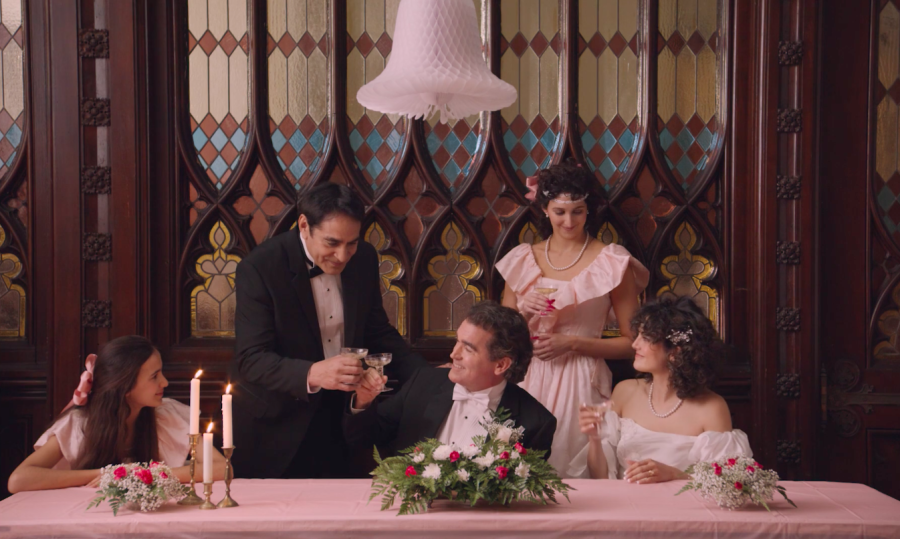Review: ‘The Cathedral’ is an understated stunner
“The Cathedral,” Ricky D’Ambrose’s latest, is carefully intimate yet captivating in its distance. The film is playing as part of New Directors / New Films 2022 at Film at Lincoln Center beginning on April 23.
The Cathedral. 2021. USA. Directed by Ricky D’Ambrose. Image courtesy Tarek Shoukri
April 22, 2022
With his sophomore feature, “The Cathedral,” director Ricky D’Ambrose, best-known for tightly constructed narrative and documentary shorts, crystallizes his highly stylized approach to storytelling.
Ostensibly, the film tells the semi-autobiographical story of Jesse Damrosch (Robert Levey II and William Bednar-Carter at different ages), an only child born in 1987 to Richard Damrosch (Brian d’Arcy James) and Lydia Damrosch (Monica Barbaro). However, D’Ambrose follows the story’s central character with such distance and deliberately cold calculation that the film becomes more of a visceral journey through Jesse’s scattered memories and childhood than a focused telling of his life’s story.
D’Ambrose devotes significant energy to developing a rich and loving sense of time and place, bringing a specificity to the film that grounds some of its more nebulous moments. Throughout “The Cathedral,” lengthy clips of news reports and other television footage from the 1990s, when Jesse was growing up, help move along the chronology of the film.
In a later scene, Richard informs the young Jesse that his uncle has died of liver failure. Through a scene between Richard and Lydia, we know this to be an obvious concealment of his HIV diagnosis. D’Ambrose shows the ways in which Jesse’s perspective is shaped by his family standing between him and his reality.
Later on, D’Ambrose deploys news clips of the 1993 World Trade Center bombing. As Jesse is distracted during his grandmother’s funeral, we see clips of debris from a crashed jet plane strewn over the expansive ocean. So often, it seems as if the chaos and confusion of the world around him comes crashing in as he becomes more conscious of the conflict present in his own life.
D’Ambrose could have easily veered into heavy-handedness with the inclusion of these interludes, but his delicate approach keeps everything feeling just distant enough that it becomes more akin to the fractured memories of an adolescent than a manufactured emotional zenith. “The Cathedral” demonstrates how information and events are gathered and warped by memory into a semi-coherent slideshow of what is and is not fully grasped. The moments where this external footage and the world of the film gradually start to merge and become one is a staggering depiction of the realizations that adulthood unearths. The barrier between Jesse and the adult world becomes increasingly porous as he grows up.
Jesse often seems to experience the world around him as an outsider, especially in situations revolving around his fractured family. He watches his parents’ divorce, his father’s fights with his ex-wife’s father and the death of his grandmother, all with the awestruck sort of half-absorption that comes with the naivete of youth. The only times in which he seems to really connect with another person are a series of delicate scenes with his grandmother Josephine (Candy Dato). Part of a quietly masterful performance, these short moments are made memorable by their quiet intimacy.
D’Ambrose’s visual sensibility largely serves to echo and get distance from his own childhood. D’Ambrose and cinematographer Bart Cortright (carried over from his previous feature “Notes on an Appearance”) focus on lingering, carefully constructed shots that highlight the inanimate and everyday.
Most impressive are the ways in which D’Ambrose’s experimental approach focuses on the unseen throughout “The Cathedral.” As if viewing the story through Jesse’s recollections, we are often given only the aftermath or something off to the side of an event. Much information is acutely conveyed through these partial insights.
A particularly memorable example comes when Richard is mustering the courage to begin his mother’s eulogy. Catching his breath while holding back tears, barely able to spit out a word, the camera cuts away just before it begins. Rather, we see Jesse and his cousin studying the lifelines of their palms while Richard presumably continues on. Often entire scenes play out in which we see just one or neither of the speaking parties.
D’Ambrose’s ”The Cathedral” is a staggering experiment in form that manages the delicate balancing act of uncompromising storytelling. Through his visual simulations of childhood, D’Ambrose creates a fractured scrapbook of a family’s history through the eyes of a child.
A striking sequence in which Jesse gives a presentation on a personal photograph for class, the camera lingering on a photo of his two aunts in his father’s apartment, is a visceral expression of the almost talismanic significance an object can hold in memory. One of the most surprising and deeply moving moments of any recent film, its arrival literally freezes time.
The rhythm D’Ambrose builds into the film makes his decision to end it with a grinding halt extremely powerful. With a simple photograph, Jesse finds his voice; through the visual language of a physical memory — perhaps akin to the filmmaker who his character is partially based on — he is able to make sense of the world around him.
Contact Holden Lay at [email protected].

























































































































































